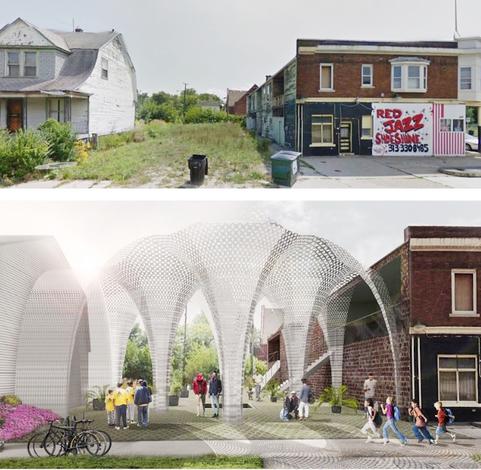
This article was originally published on February 25, 2020.
There was a vacant lot that Keviyan Richardson regularly mowed at the corner of Oakland and Euclid in Detroit. Just five minutes from where he lives, Richardson maintained the space and watched the vacant homes on either side of it to make sure no one broke in. He says others in Detroit’s North End neighborhood helped too by removing unwanted foliage and picking up trash.
Today Richardson, an urban and regional studies major, still spends time at the Oakland Avenue location. But he now interacts with the space differently — as do people throughout the neighborhood.
There's a two-story stainless steel art structure called American Riad (an Arabic word for garden) on the once empty lot. The 40-foot structure has multiple canopies and is interlaid with finely done geometric shapes. When the light shines through it, there’s a beautiful pattern on the ground. But not only is it attractive, people in the neighborhood have had cookouts, poetry readings, summer youth camps, and concerts there. The land is considered Michigan’s first community land trust, which means that residents are all partial owners.
Richardson says it’s brought energy to the neighborhood that, like many others in the city, feels a bit disconnected with all of the talk about revitalization in Detroit. “What’s happening downtown isn’t what our neighborhoods are experiencing. So we need to work together. That starts by getting to know the people around you, finding out what’s needed and looking for ways to make it happen.”
To better understand how to get things in motion, Richardson enrolled in UM-Dearborn’s urban and regional studies program in 2017. He said the prestige of the Michigan name and close-to-home location enticed him to check out campus — and the major sealed the deal.
“I’ve used so much of what I’ve learned in class in the work I’m doing in Detroit,” he says, noting that he often sees faculty like Geography and Urban and Regional Studies Assistant Professor Joshua Akers and Sociology Professor Paul Draus working in Detroit’s neighborhoods too. “My professors know what they are talking about because they are on the ground with us. They are at neighborhood meetings, community workshops, farmer’s markets, everywhere.” The program’s goal is to provide knowledge, techniques and critical analytical skills to enable students to effectively participate in changing your city and region.
Richardson — who’s taught urban farming, run summer youth camps and creates parks for the Detroit skateboarding scene — says the American Riad project is one of the largest neighborhood projects he’s done. This past summer he was a part of the North End neighborhood installment crew who began building up the corner lot by adding the stainless structure.
Richardson says the large vacant houses on either side of the courtyard will be turned into affordable housing and the courtyard will expand in future phases to incorporate more ways for the community to engage. He’s also excited to add his spin to it — he’s planning to design a skate park that will be incorporated into the space in a later phase.

Richardson, who’s lived in Detroit his entire life, says knowing your neighbors allows you to help where needed. With voids between homes, a lack of organized community space, and the single-family structures, sometimes people don’t reach out. As someone planning to work in urban development, Richardson knows that connection is critical.
Though his involvement with the Oakland Avenue Artists Coalition, a major partner in the multi-year project, Richardson says he’s seen what can happen when people work together for common good.
“I wanted to learn how to do right by my community and how to create what we need to succeed; it’s why I’m earning my degree,” he says. “Don’t live in a space that no longer works well for you. Instead, go out and work to mold your community in a way that will help you and your neighbors succeed.”



